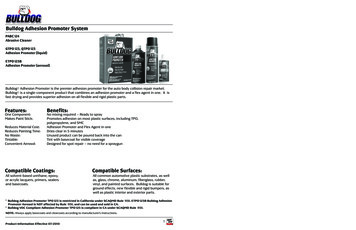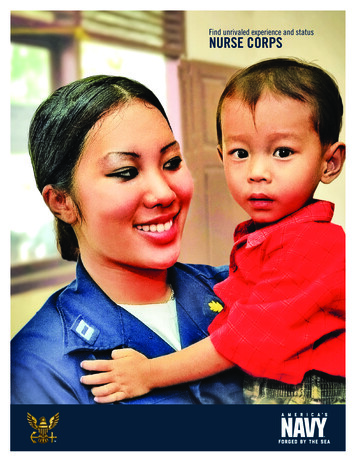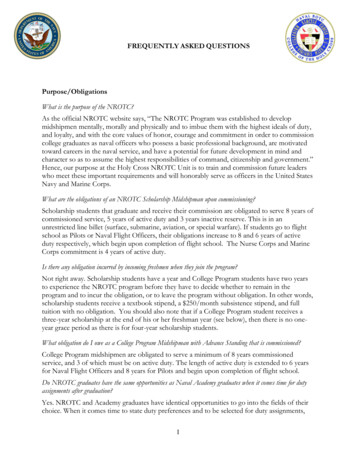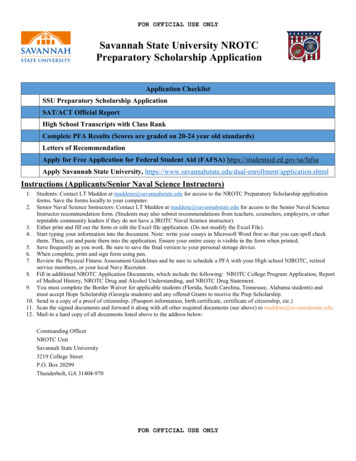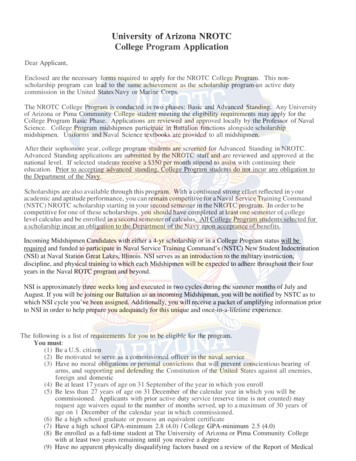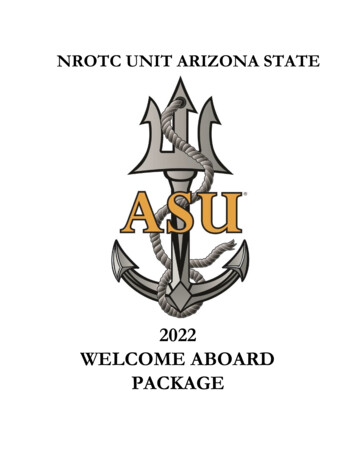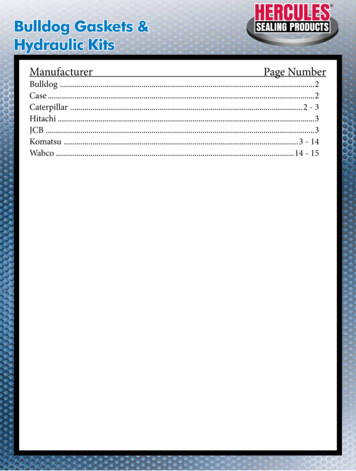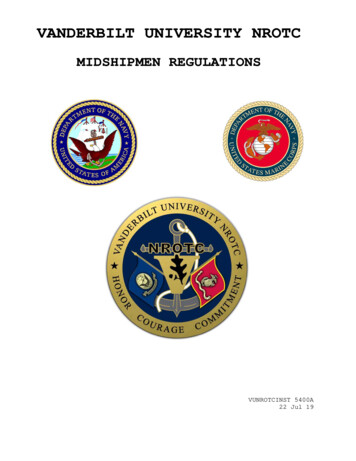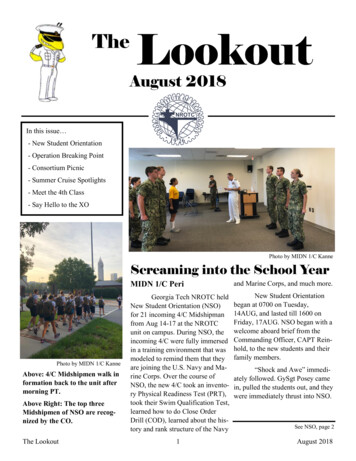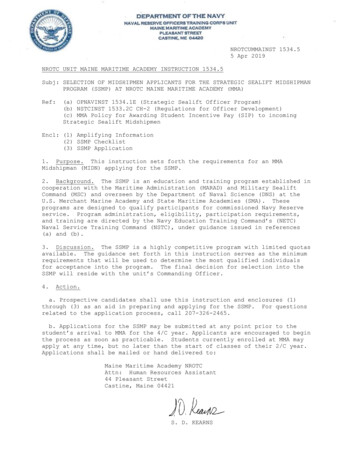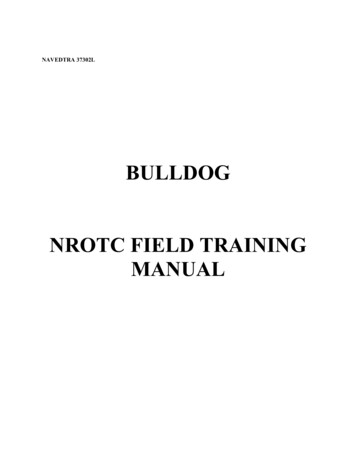
Transcription
NAVEDTRA 37302LBULLDOGNROTC FIELD TRAININGMANUAL
PREFACEThe Field Training Manual has been prepared to serve as a guide for Marine Option Midshipmen andMECEP students who will participate in Officer Candidates School (BULLDOG). The contents ofchapters one through five will remain unchanged from year to year. Only the appendices will be updatedon a yearly basis.ReviewedReviewed and ApprovedColonel C. M. AcreeSenior Marine Representative, CNETK. A. RayburnCaptain, U.S. NavyHead, NROTC Professional Developmenti
REPORT OF CHANGESChanges to these regulations will be promulgated with consecutiveidentifying-change numbers. Holders will record the changeinformation below.CHANGENUMBERAUTHORITYDATE ENTEREDBYii
QUANTICO HISTORYQuantico, the heart of development and military education for the United States Marine Corps, islocated on a 62,000 acre tract of land along the Potomac River in northern Virginia. Its name means "bythe large stream," a term used by Indians who once lived there in the wooded Virginia hills.Its military history dates back to 1775, with the Commonwealth of Virginia establishing a Navy of 72vessels and utilizing Quantico as a base of operations for the fleet.During the Civil War, Confederate gun batteries located at Quantico blocked the shipping lane of thePotomac River, blockading the Federal capital for a long period of time.Marine Corps interests in Quantico began in 1917 as U.S. participation in World War I becameimminent. At that time Major General George Barnett, 12th Commandant of the Marine Corps, ordered anew training camp established that could house 7,500 Marines. The main criteria for the site was that ithad to be on land lying next to a body of water and suitable for troop maneuvers and target practice.A 5,300 acre tract, meeting all the specifications, was found at Quantico, approximately 35 miles southof Washington, DC.The first Marines arrived at Quantico on May 14, 1917, after transfer from the Annapolis, Maryland,Marine Barracks. They were joined later by a light artillery battalion and the 6th and 8th MarineRegiments. The units were known as the Advanced Base Force.Throughout World War I, thousands of Marines trained at Quantico, including the famed 4th MarineBrigade which later served in France.In December 1918, the Quantico site was purchased, and the Secretary of the Navy authorized theMarine Corps to develop Quantico as a permanent base.The Marine Corps Schools, forerunner of the present Marine Corps Combat Development Command(MCCDC), were established at Quantico in 1921, when Major General John A. Lejeune, 13thCommandant of the Marine Corps, decided that existing educational facilities for Marines wereinadequate.The 1920's saw the transition of Quantico from a tent city to a permanent Marine Corps Base. It alsosaw the early realization of the idea that a war with Japan was a distinct future possibility.To meet this prospect, it was clear that a successful offensive against the Japanese would requireseizure--by amphibious assault--of a chain of naval bases and islands across the Pacific.New concepts, new skills, and new equipment were essential requirements in order to accomplish this.Quantico, well equipped to undertake and develop the necessary plans for such a task, became the focalpoint of amphibious warfare development.By 1935, Marine Corps Schools completed a "Tentative Landing Operations Manual," which wasadopted intact by the U.S. Navy in 1938. In 1941, the U.S. Army borrowed the text verbatim when itissued its first amphibious manual.Equipment for the implementation of the amphibious manual was developed at Quantico by the MarineCorps Equipment Board. The forerunner of the Marine Corps Systems Command, this agency assumed1
leadership in the development of new devices needed to conduct and support military operations acrossthe natural barrier presented by a shoreline.Among the new developments and ideas formulated at the time was the concept of close air support fortroops on the ground. Under this concept, the commander of a ground unit could call for air support todeliver aerial ordnance on enemy targets, including those near his own position. This doctrine is verymuch alive and in use today.Meanwhile, the Advanced Base Force had become the East Coast Expeditionary Force in 1921, and theFleet Marine Force in 1935. It played its part in amphibious development by putting to practical test thedoctrines and equipment evolved and invented respectively at Marine Corps Schools and the EquipmentBoard.As a result of the pioneering work of the Marine Corps in the 1920's and 1930's, the United States wasready for amphibious warfare which later made possible the invasion of North Africa, Europe, and thesweep across the Pacific during World War II.With the move of the Fleet Marine Force in 1941 from Quantico to Camp Lejeune and Cherry Point,North Carolina, the principal mission of Quantico became the individual education of Marines asdistinguished from unit training.The advent of World War II greatly accelerated the growth and pace of Quantico. In 1942, some50,000 acres west of U.S. Highway 1 were added to the base to provide much needed maneuver, firing,and bombing ranges.During the war, 15,000 second lieutenants were commissioned at the schools and another 20,000Marine officers received specialized and advanced training at Quantico. In addition, officers from theArmy, Navy, and allied countries also studied at Quantico.With the end of World War II and the advent of the nuclear age, Marine Corps Schools introduced anew amphibious concept--one that would improve conventional landings as well as operations involvingthe possible use of atomic weapons.This new concept was based on the helicopter. This experimental aircraft offered a rapid means ofmoving troops from scattered ships to shore, while allowing the fighting men to bypass heavily defendedbeaches and attack them from the rear.To help test this concept, Marine Helicopter Squadron One (HMX-1) was established at Quantico in1947.In 1950, Korea became the proving ground for the techniques developed. During the bitter fightingthere, entire Marine battalions were transported to the front and regiments were frequently supplied byhelicopters. Ten thousand Marines were evacuated the same way--by Marine helicopters.The doctrines and equipment perfected at Quantico proved themselves in Vietnam.On 1 January 1968, Quantico dropped the title Marine Corps Schools and became the Marine CorpsDevelopment and Education Command (MCDEC). The focus of Quantico was further refined whenMCDEC became the Marine Corps Combat Development Command (MCCDC) on 10 November 1987.2
In addition to developing contemporary military doctrine and tactics, Quantico offers progressiveeducation at the basic, intermediate, and career levels for Marine officers as well as military professionaleducation for Marine Corps staff noncommissioned officers. Further, the Combat DevelopmentCommand was proactive in the evolution of doctrine, techniques, and training which contributedsubstantially to the success of Operation Desert Storm in Southwest Asia in 1991.From its inception, the Marine Corps has recognized that professionally trained and highly motivatedindividuals are needed to guide the organization. Leadership has been and will always remain thewatchword of the Marine Corps. All activities at Quantico are geared toward developing andstrengthening that quality, particularly in Marine officers.Today, the Marine Corps has reduced its ranks to a hard core of dedicated men and women. People ofconviction who seek a challenging career are being chosen to fill the ranks. At Quantico the educationand development of new officers begins. From this touchstone, they step off as "Officers of Marines" tomeet the challenges of command which await them in today's Marine Corps.3
TABLE OF CONTENTSCHAPTER IGENERALPage1. Marine Corps Combat Development Command, Quantico, Virginia --------------- 62. Mission of the Officer Candidates School ---------------------------------------------- 63. Reporting/Outposting Information ----- 6CHAPTER IIORGANIZATION AND ADMINISTRATION1.2.3.4.5.6.7.Training Organization ------------------- 11Leadership Billets ------------------------ 11Quarters ------------------------------------ 11Messing ------------------------------------ 11Pay ------------------------------------------ 11Club Facilities ----------------------------- 12Daily Routine ----------------------------- 12CHAPTER IIITRAINING1.2.3.4.Training Period --------------------------- 13Scope of Training ------------------------- 13Evaluation --------------------------------- 13Physical Examinations ------------------- 15CHAPTER IVLEADERSHIP, CONDUCT, AND APTITUDE1.2.3.4.5.Discipline and Conduct ------------------ 17Leadership Traits ------------------------- 17Leadership Principles -------------------- 18Leadership Reports ----------------------- 18Final Aptitude Reports ------------------- 184
CHAPTER VMISCELLANEOUS1.2.3.4.5.6.7.Mail ----------------------------------------- 20Visitors ------------------------------------- 20Religious Services ------------------------ 20Arms and Ammunition ------------------ 20Athletics and Recreation ----------------- 20Facilities of MCCDC -------------------- 20Liberty/Leave ----------------------------- 20APPENDICESAppendix AAppendix BAppendix CAppendix DChecklist for reporting to BULLDOG ------------------------------------ A-1MOI's Guide for Preparing Midshipmen for BULLDOG/ Notes fromOCS and the Golf Company Commanders ------------------------------- B-1Information Pertaining to MECEP's -------------------------------------- C-1Notes from OCS and the Golf Company Commanders------------------D-15
CHAPTER IGENERAL1. MARINE CORPS COMBAT DEVELOPMENT COMMAND, QUANTICO, VIRGINIA. Summertraining for Marine Corps officer candidates is conducted at the Officer Candidates School, Marine CorpsCombat Development Command, Quantico, Virginia. Most of the formal officer schools of the MarineCorps are located at Quantico and include: The Marine Corps War College, Amphibious Warfare School,The Basic School, Communication Officers School, and Computer Sciences School. Here, also, is theMarine Corps Systems Command. It is assigned the mission of developing and evaluating equipment andrecommending the acquisition of items for employment with Marine forces. Marine Corps CombatDevelopment Command is the home of HMX-1, the Marine Helicopter Squadron which pioneered thedevelopment and use of helicopters by the Marine Corps and evolved the tactics for their use in modernwarfare. As the Presidential Squadron, HMX-1 provides helicopter support for the President of theUnited States.2. MISSION OF THE OFFICER CANDIDATES SCHOOL (OCS). The mission of OCS is to train,evaluate, and screen officer candidates to ensure that they possess the moral, intellectual, and physicalqualities for commissioning and the leadership potential to serve successfully as company-grade officersin the Fleet Marine Force.a. Evaluation of leadership potential is accomplished through the use of observation reports, leadershipratings, graded examinations, peer evaluations, and various practical applications. Each candidate isplaced in leadership billets and situations and is evaluated on his/her performance by supervisorypersonnel. This is supplemented by constructive counseling designed to assess individual performanceand identify leadership deficiencies.b. Moral qualities are evaluated commensurate with leadership qualities. Observation reports,leadership ratings, peer evaluations, and observation and counseling by supervisory personnel aredesigned to assess individual moral courage and conduct as part of leadership potential.c. Physical fitness evaluation is accomplished by a progressive physical fitness program and a series ofpractical application tests. This program is not designed exclusively for the candidate to successfully passall the categories of the physical fitness test, but rather is designed to evaluate total fitness. The physicalcondition of the candidate is evaluated by various practical evaluations which measure his/her strengthand endurance.3. REPORTING/OUTPOSTING INFORMATIONa. Purpose. The OCS summer training program is designed to evaluate the performance of theindividual candidate. Therefore, the daily routine and weekly schedule experienced by the candidate willbe a reflection of the training required to be accomplished, and liberty will be granted accordingly.b. Reporting(1) The following is provided as a generic sequence of events for the preparation and arrival ofmidshipmen/ MECEPs. Candidates reporting for training should arrive in accordance with separatecorrespondence published annually for the following companies:Golf Company (1st Increment)Hotel Company (If Required)6
Golf Company (2nd Increment)Candidates will be directed to report on the appropriate day from 0800-1400. Candidates are advised tomake every attempt possible to arrive prior to 1200 to facilitate inprocessing and integration into aplatoon. Those candidates who cannot arrive by 1400 on the designated day should arrive the day prior.When provided with advance notification, Officer Candidates School will provide billeting for thosecandidates who need to arrive one day early.(2) A Marine Liaison Team from Officer Candidates School will meet candidates at WashingtonNational Airport and provide transportation to Officer Candidates School. Commercial buses departregularly from Dulles International to Washington National Airport. The cost of the transportation,approximately 4.50, is reimbursable. Candidates encountering problems in the Washington area maycall Officer Candidates School at (703) 784-2077/2529. After working hours call (703) 784-2351/2352.(3) Candidates should report to Officer Candidates School with the following documents: Originaland five copies of their orders, ID card with social security number, health record (including a history ofinoculations) , and dental record. To meet financial requirements, candidates must report with aminimum of 300.(4) Candidates having prior service shall bring copies of all DD-214's. ECP and active dutyreservists must bring their SRB, medical and dental records.(5) All candidates who are married, divorced and/or claiming children must bring all documentationto substantiate a claim. Documents include marriage certificates, divorce decrees, birth certificates, andadoption papers. If a candidate's spouse is prior service, a DD-214 must be presented. Alsorental/mortgage agreements must be brought. Candidates will hand carry these documents and presentthem upon initial in-processing.c. Transportation to and from Quantico(1) Government Transportation Request. In general, travel to Quantico should be accomplishedusing a round trip rail or air Government Travel Request issued by the NROTC units. Members of theNROTC are entitled to travel and transportation allowances as prescribed in Joint Travel Regulations,paragraph M-6004.2.3. Candidates will submit travel claims at OCS during administrative processing asprovided by Naval Travel Instructions, paragraph 6003.3. Each student will be responsible for thesafekeeping of his/her own ticket. Lost tickets or transportation requests will not be replaced atGovernment expense.(2) Privately-Owned Conveyance. Candidates may travel by private automobile if they desire;however, the use of privately-owned conveyance is discouraged for NROTC students. Candidates sodoing will report to Headquarters, Officer Candidates School, Building 2189, MCCDC, Quantico,Virginia. NROTC candidates desiring to bring their cars on the reservation will be required to furnishevidence of liability insurance in the amounts of: 20,000 property damage, 25,000 bodily injuryliability per person, and 50,000 per accident minimum. In addition, uninsured motorist insurance isrequired. Candidates will also be required to show a state car registration, a valid driver's license from thesame state, and, if the car belongs to parents or a friend, they must furnish two copies of writtenpermission to operate the car.d. Clothing and Equipment7
(1) Candidates should report to Quantico in appropriate seasonal civilian attire. Appropriateseasonal civilian attire is a collared shirt and a pair of trousers with belt. Civilian attire should beserviceable but not expensive/new as candidates will be clothed in civilian attire until issued militaryuniforms. Blue jeans, shorts and T-shirts will not be worn. Candidates should pack running shoes inreadily accessible location.(2) Marine Corps Combat Development Command will issue Marine Corps clothing and equipmentnecessary for all instruction, at no expense to the individual, with exception of the material listed insubparagraphs (3) and (4) below.(3) The items listed below are required for use during training. This list will vary from year to year.An updated list will be published by OCS and then forwarded by MCRC(ON) by May 1st. These itemsmust be purchased during in-processing. The individual candidate will pay the cost of both bag issues.No refunds or partial issues will be granted.(a) Small Bag Issue (approximate cost: Male- 80; Female- 75)1 Soap2 Towels1 Washcloth1 Soap dish1 pack of 3 locks1 Flashlight, Angle head1 Batteries, set1 3 x 5 Notebook1 Pair Shower Shoes1 Highlighter1 Sports Bra (female only)2 Jock Straps (males only)1 Spenco Polysorb Insoles1 Grid Protractor1 Book of Stamps1 Loose Leaf Binder1 Notebook Paper3 Name Tapes1 Package of 2 Ink Pens1 Laundry Bag1 Writing Portfolio(b) Large Bag Issue (approximate cost: 85)1 Mouth guard2 Towels2 Pair Sweat Socks1 Wash Cloth2 Pair Green PT Shorts1 Sewing Kit1 Shoe Dauber1 Shoe Brush1 Large Shoe Polish1 Foot Powder1 Package of 2 Boot Bands1 Package Q-Tips1 Marking Kit1 Laundry Bag1 Nail Brush1 Nail Clipper, Large1 Nail Clipper, Small1 Scrub Brush1 Roll Cloth Tape1 Can Never Dull1 4 oz. Btl Break Free (CLP)1 Pair Blousing Tab (cammie)1 Paint Brush2 Pencils1 Campstool1 Black Marker1 Box Detergent1 Saddle Soap4 T-shirts(4) Important. It is absolutely essential that candidates report with their own running shoes and2 pairs of well "broken in" boots. Boots must be issued 6 months prior to OCS to allow candidates the8
opportunity to train in them. Boot preparation and foot conditioning are vital and cannot beoveremphasized.e. Physical Conditioning(1) The Marine Corps places particular emphasis on the necessity of maintaining a high degree ofphysical fitness. An officer of Marines must be capable of sustained activity in the face of adverseconditions. Leadership by personal example often requires that an officer perform under fatiguingconditions. With this in mind, the physical aspects of the program at OCS are demanding.(2) The training at OCS requires physical strength and endurance. Candidates should report to OCSin excellent physical condition. Upper body strength and stamina are particularly important. Uponreporting, each candidate will be administered the Marine Corps Physical Fitness Test (PFT). Minimumstandards are required, however, higher levels are necessary as training progresses. Each candidateshould realize that the initial impression made on peers and the OCS staff is very important. The trainingschedule cannot be geared to men and women in poor physical condition. Those candidates who arecontent to report to OCS capable of performing only the minimum standards on the PFT will findthemselves falling behind. The rigors of OCS physical training and test events require considerably moreexertion than mere periodic running of the PFT. Candidates must arrive at OCS and obtain a firstclass PFT (225 points) on the initial physical fitness test. Candidates who fail to obtain a first-classinitial PFT may be disenrolled.(3) The following are historical averages for the inventory Physical Fitness Test:TEST EVENTMalePullupsCrunches (2 min.)3-Mile RunFemale Flexed Arm HangCrunches (2 min.)3-Mile RunOCS TIAL AVERAGE77024:002010018:0015-1693-9420:2940 sec.7028:0070 sec.10021:0060-66 sec.93-9424:30-25:00It is obvious that most candidates report to OCS in a physical condition well above the minimumstandards. However, experience indicates the attainment of minimum physical fitness standards will by nomeans ensure successful completion of the physical aspects of BULLDOG. Candidates are expected toreport to OCS in outstanding physical condition. In order to ensure the greatest chances of success,standardized physical training requirements are outlined in Appendix B.(4) Serious blisters continue to be a problem during the first 3 weeks of training. These blisterscause candidates to lose irreplaceable training time and adversely affect overall individual training.Almost all these problems could be eliminated by candidates undertaking an intensive foot conditioningprogram. Candidates should be knowledgeable of proper foot care to include the wearing of two pairs ofsocks (one thin regular pair covered by one pair standard military boot sock), the use of Spenco inserts,and the use of moleskin.(5) Swimming conditioning and testing are not conducted at OCS. All candidates are required tohave been swim qualified in accordance with CNET Instruction 1533.12(Ser).9
f. Maximum Weight Allowances(1) As noted in the Manual of the Medical Department, U.S. Navy (NAVMEDMAN) and CNETregulations (CNETINST 1533.12) the procurement weight standards apply to initial entry applicants only.Upon enrollment, Marine Option midshipmen are required to adhere to the standards specified in MCO6100.10(Ser), Weight Control and Military Appearance.(2) All candidates shall be examined during medical processing at OCS to ensure compliance withthe standards established in MCO 6100.10(Ser). Candidates found to exceed weight standards will bedisenrolled as not physically qualified.g. Outposting(1) Training for the candidates will be conducted as prescribed in separate correspondence publishedannually for the following companies:Company G (1st Increment)Company HCompany G (2nd Increment)(2) Outposting takes place on the final day of training. A graduation parade is held, followed by areception with refreshments at Brown Field. Parents and guests are invited and encouraged to attend theceremony.(3) It is the responsibility of the candidate and NROTC unit to ensure that round trip transportation isarranged prior to reporting to OCS. Departure from Quantico should be planned for 1300 or latergraduation day.10
CHAPTER IIORGANIZATION AND ADMINISTRATION1. TRAINING ORGANIZATION. Male candidates will be organized into one 6-week training companyin each increment. The female candidates will be assigned to a 6-week company which includes male andfemale candidates. Within the company, candidates will be further assigned to platoons and squads. Thecommanding officers of the companies are usually majors and the platoon commanders are usuallycaptains. Platoon Sergeants are usually Gunnery Sergeants or Staff Sergeants. Sergeant instructors areusually Staff Sergeants or Sergeants.2. LEADERSHIP BILLETS. Candidates are assigned leadership billets on a rotating basis to providethem with leadership experience and acquaint them with responsibilities associated with leadership.Leadership billets consist of the following:Candidate Billetsa. Candidate Company Commanderb. Candidate Executive Officerc. Candidate Platoon Commanderd. Candidate First Sergeante. Candidate Gunnery Sergeantf. Candidate Platoon Sergeantg. Candidate Platoon Guideh. Candidate Squad Leaderi. Candidate Fire Team Leader3. QUARTERS. Candidates will be billeted in the OCS barracks. Each candidate will be assigned a walllocker and foot locker for storage of gear.4. MESSING. Candidates will eat in the OCS Dining Facility while undergoing training.5. PAYa. NROTC candidates will be paid 80 percent of their authorized pay in advance by the NROTC unit.This action must be accomplished prior to arrival at OCS as no payments will be authorized formidshipmen during training. Final settlement of pay and travel claims will be accomplished by theNROTC unit. Because of the expenses that each candidate will face at the commencement of training, thenecessity of each candidate reporting with a minimum of 300 is reemphasized.b. All MECEP candidates should be enrolled in the Direct Deposit Program and must also report with 300 for initial expenses.11
6. CLUB FACILITIES. Midshipmen and MECEP students in a training status are not permitted to useany of the club facilities: officer, SNCO, NCO, or enlisted.7. DAILY ROUTINE. The summertime routine at Officer Candidates School commences at 0500 withreveille. Prior to breakfast, policing of the barracks is conducted. The training day is normally conductedfrom 0600 to 2100. Some periods of field training are conducted at night. Taps is normally sounded at2200.12
CHAPTER IIITRAINING1. TRAINING PERIOD. The summer training period for male and female NROTC and MECEPcandidates is 6 weeks in duration for both scholarship and college program midshipmen. This trainingperiod will not be extended nor will candidates be assigned to other training without prior formalapproval of the Chief of Naval Education and Training (OTE1M). A waiver may be granted when theMarine Corps assumes funding responsibility for all costs associated with an extended trainingassignment. Candidates normally will not be permitted to leave training early for personal reasons of anon-emergency nature, e.g., football practice, summer school, or summer employment.2. SCOPE OF TRAINING. Officer Candidates School provides basic instruction and evaluation ingeneral military subjects, some of which are not covered by the Naval Science curriculum. Progressivephysical training and practical leadership application in tactical and administrative billets are also presented. Instruction is usually given in 50-minute increments, followed by a 10-minute break. Instruction ispresented by lecture, demonstration, and/or practical application, frequently employing the use of varioustraining aids.3. EVALUATIONa. The evaluation system provides a method and a basis for evaluating a candidate's fitness forcommissioning. All candidates entering training possess the prerequisites for the program through whichthey seek appointment to commissioned grade. The training is directive in nature. The candidate'sapproach to the program, individual performance, and overall improvement provide the composite scoringfor a final percentage grade. These grades determine key billet holders for parades and recipients ofappropriate awards upon completion of the course.b. Evaluation of a candidate's performance is conducted in three categories:(1) Academics. The necessary general military subjects required to evaluate the candidate's ability toassimilate and utilize military instruction. Determines 25 percent of the candidate's final overall grade.(2) Physical Training. Physical training designed to condition and evaluate the candidate physicallyand mentally for duty as a Marine officer. Determines 25 percent of the candidate's final overall grade.(3) Leadership. Daily performance in graded and non-graded events including administrative andtactical billets assigned to determine leadership potential. Determines 50 percent of the candidate's finaloverall grade.c. Certain evaluated events are assigned percentage weights based on their relevance in measuringaptitude for commissioned service. These events and their weights are shown below in their normalsequence.13
EVENTPERCENTAGEAcademicsWeapons Performance3Weapons3General Military Subjects III4Tactics I4Tactics II5Compass Course Day3Compass Course Night3Subtotal:25Physical FitnessInitial PFT2Combat Readiness Test6Obstacle Course5Final PFT4Endurance Course8Subtotal:2514
LeadershipDrill Evaluation2Leadership I2Leadership II2Small Unit Leadership Evaluation I5Small Unit Leadership Evaluation II14Command Evaluation25Subtotal:50Total:100d. The grading criteria for evaluated events are set forth below:(1) factoryMarginalAverageAbove AverageExcellentOutstanding(2) Eighty percent is considered to be a minimum passing grade in all areas of testing and evaluation.Minimum passing grades are considered marginal and are grounds for a candidate's appearance before anevaluation board.4. PHYSICAL EXAMINATION. All midshipmen and MECEP candidates must report to OfficerCandidates School with a complete physical examination. Units located in close proximity to militarymedical facilities should use those facilities to the maximum extent possible. In those cases wheremidshipmen have und
Marine Corps to develop Quantico as a permanent base. The Marine Corps Schools, forerunner of the present Marine Corps Combat Development Command (MCCDC), were established at Quantico in 1921, when Major General John A. Lejeune, 13th Commandant of the Marine Corps, decided that existing educational facilities for Marines were inadequate.
